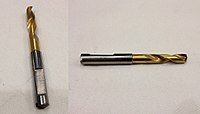Surface finishing

Surface finishing is like giving a toy a shiny polish. Imagine you have a toy car that's made of plastic or metal. When it's made, it might have rough edges or burrs that could scrape or hurt someone. So, we need to smooth it down and make it safe to play with.
Surface finishing does the same thing for metal or plastic pieces. It's a process of sanding, polishing, and smoothing out rough surfaces to make them look nice, and all the sharp edges go away. This can be done by hands or machines.
Now, think of it this way: imagine you have a glass of milk, and it has some chocolate powder in it that you want to mix. If you stir it with a spoon, you could end up with lumps or clumps, and nobody likes them in their chocolate milk!
Instead, you want to stir it so much that the milk and powder mix perfectly, and you can't even see the chocolate powder in the milk. The milk should be smooth, creamy, and delicious. Surface finishing does that, it blends all the materials together into a smooth surface.
After the surface is smoothed out, it can be painted, plated, or left as it is, and it will look much better than before.
That's how surface finishing makes sure everything is safe from sharp edges, nice to look at, and even good enough to eat!
Surface finishing does the same thing for metal or plastic pieces. It's a process of sanding, polishing, and smoothing out rough surfaces to make them look nice, and all the sharp edges go away. This can be done by hands or machines.
Now, think of it this way: imagine you have a glass of milk, and it has some chocolate powder in it that you want to mix. If you stir it with a spoon, you could end up with lumps or clumps, and nobody likes them in their chocolate milk!
Instead, you want to stir it so much that the milk and powder mix perfectly, and you can't even see the chocolate powder in the milk. The milk should be smooth, creamy, and delicious. Surface finishing does that, it blends all the materials together into a smooth surface.
After the surface is smoothed out, it can be painted, plated, or left as it is, and it will look much better than before.
That's how surface finishing makes sure everything is safe from sharp edges, nice to look at, and even good enough to eat!
Related topics others have asked about:
